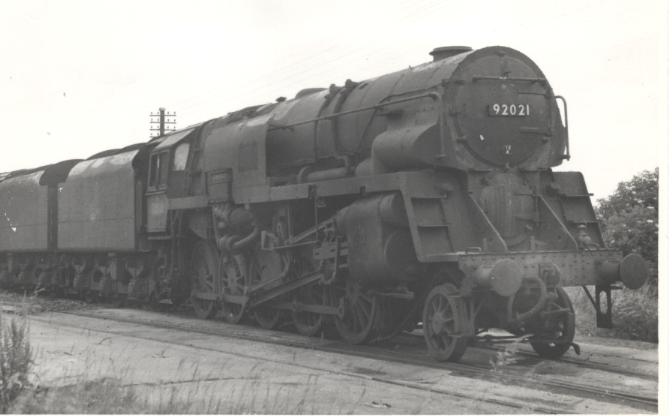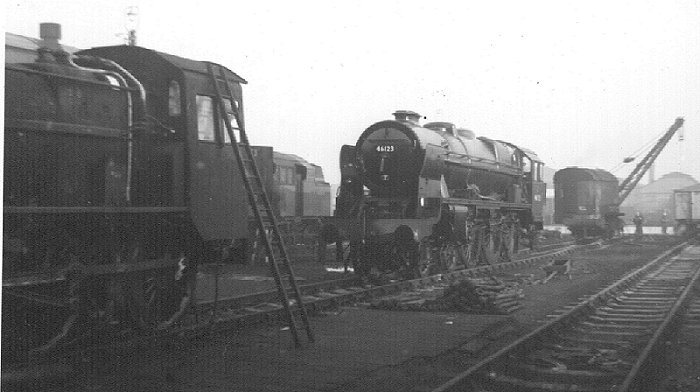|
BR Standard Class 9F 92020-9
British Railways Standard Class 9F steam locomotives Nos 92020-9 were experimentally built with Franco-Crosti boilers, thus forming a subclass. All ten were built in 1955 at Crewe Works. The Franco-Crosti boiler took the form of a single cylindrical water drum running along the underside of the main boiler barrel; the standard chimney at the front was only used during lighting-up, in normal working the gases went through firetubes inside the preheater drum that led to a second smokebox situated beneath the boiler from which there emerged a chimney on the right-hand side (fireman's), just forward of the firebox. Limitations of the British loading gauge meant that the original BR9 boiler had to be reduced in diameter to allow for the preheater drum below it. This new BR9A, later BR12, boiler had a reduced heating surface compared to the original, even with the additional preheater. Without the preheater, there was over 1,000 sq ft less heating surface. In the event, the expe ... [...More Info...] [...Related Items...] OR: [Wikipedia] [Google] [Baidu] |
British Railways
British Railways (BR), which from 1965 traded as British Rail, was a state-owned company that operated most of the overground rail transport in Great Britain from 1948 to 1997. It was formed from the nationalisation of the Big Four British railway companies, and was privatised in stages between 1994 and 1997. Originally a trading brand of the Railway Executive of the British Transport Commission, it became an independent statutory corporation in January 1963, when it was formally renamed the British Railways Board. The period of nationalisation saw sweeping changes in the railway. A process of dieselisation and electrification took place, and by 1968 steam locomotives had been entirely replaced by diesel and electric traction, except for the Vale of Rheidol Railway (a narrow-gauge tourist line). Passengers replaced freight as the main source of business, and one-third of the network was closed by the Beeching cuts of the 1960s in an effort to reduce rail subsidies. On privatis ... [...More Info...] [...Related Items...] OR: [Wikipedia] [Google] [Baidu] |
BR Standard Class 9F
The British Railways Standard Class 9F 2-10-0 is a class of steam locomotive designed for British Railways by Robert Riddles. The Class 9F was the last in a series of standardised locomotive classes designed for British Railways during the 1950s, and was intended for use on fast, heavy freight trains over long distances. It was one of the most powerful steam locomotive types ever built for British Railways, and successfully performed its intended duties. The class was given the nickname of 'Spaceships', due to its size and shape. At various times during the 1950s, the 9Fs worked passenger trains with great success, indicating the versatility of the design, sometimes considered to represent the ultimate in British steam development. Several experimental variants were constructed in an effort to reduce costs and maintenance, although these met with varying degrees of success. They were also capable of reaching speeds of up to 90 miles per hour (145 km/h). The total number ... [...More Info...] [...Related Items...] OR: [Wikipedia] [Google] [Baidu] |
Steam Locomotives
A steam locomotive is a locomotive that provides the force to move itself and other vehicles by means of the expansion of steam. It is fuelled by burning combustible material (usually coal, oil or, rarely, wood) to heat water in the locomotive's boiler to the point where it becomes gaseous and its volume increases 1,700 times. Functionally, it is a steam engine on wheels. In most locomotives, the steam is admitted alternately to each end of its cylinders, in which pistons are mechanically connected to the locomotive's main wheels. Fuel and water supplies are usually carried with the locomotive, either on the locomotive itself or in a tender coupled to it. Variations in this general design include electrically-powered boilers, turbines in place of pistons, and using steam generated externally. Steam locomotives were first developed in the United Kingdom during the early 19th century and used for railway transport until the middle of the 20th century. Richard Trevithick bui ... [...More Info...] [...Related Items...] OR: [Wikipedia] [Google] [Baidu] |
Franco-Crosti Boiler
The Franco–Crosti boiler is a type of boiler used for steam locomotives. It was designed in the 1930s by Attilio Franco and Dr Piero Crosti. The main difference between it and conventional feedwater heaters widely used on the continent is that the Franco-Crosti boiler uses both exhaust steam and exhaust gases from the firebox. Conventional feedwater heaters only use exhaust steam. Purpose The Franco–Crosti boiler is a modification of the conventional fire tube boiler design used on most steam locomotives. Unlike conventional boilers the heat remaining in the exhaust gases is used to preheat the water supply for the main boiler using a secondary heat exchange mechanism. This mechanism, known as the ''feedwater heater'' is essentially a secondary boiler. The preheated feedwater is fed at full boiler pressure into the main boiler via clack valves. The feedwater heater is not designed to produce steam, instead raising the temperature of the feedwater. This allows the heater to ... [...More Info...] [...Related Items...] OR: [Wikipedia] [Google] [Baidu] |
Crewe Works
Crewe Works is a British railway engineering facility located in the town of Crewe, Cheshire. The works, which was originally opened by the Grand Junction Railway in 1840, employed around 7,000 to 8,000 workers at its peak. In the 1980s, a lot of the engineering works were closed. Much of the site has been redeveloped but the remaining parts are owned and operated by French-owned multinational rolling stock manufacturer, Alstom SA. During the late 19th century, the London and North Western Railway used Crewe Works to produce many famous locomotives such as the Webb Jumbo class and the compounds, the Whale Experiment and Precursor classes, and the Bowen-Cooke Claughtons. In particular, Whale's 1912 superheated G1 Class developed from a locomotive introduced by Webb in 1892, lasted, in many cases until 1964, near the end of steam in 1968. After grouping, the works were taken over by London, Midland and Scottish Railway which was the successor to the LNWR. It was during ... [...More Info...] [...Related Items...] OR: [Wikipedia] [Google] [Baidu] |
Loading Gauge
A loading gauge is a diagram or physical structure that defines the maximum height and width dimensions in railway vehicles and their loads. Their purpose is to ensure that rail vehicles can pass safely through tunnels and under bridges, and keep clear of platforms, trackside buildings and structures. Classification systems vary between different countries, and gauges may vary across a network, even if the track gauge is uniform. The term loading gauge can also be applied to the maximum size of road vehicles in relation to tunnels, overpasses and bridges, and doors into automobile repair shops, bus garages, filling stations, residential garages, multi-storey car parks and warehouses. A related but separate gauge is the structure gauge, which sets limits to the extent that bridges, tunnels and other infrastructure can encroach on rail vehicles. The difference between these two gauges is called the clearance. The specified amount of clearance makes allowance for wobbling of ... [...More Info...] [...Related Items...] OR: [Wikipedia] [Google] [Baidu] |
Power Classification
A number of different numbering and classification schemes were used for the locomotives owned by the London, Midland and Scottish Railway (LMS) and its constituent companies; this page explains the principal systems that were used. The following abbreviations for the constituent companies are used on this page: * ''Principal Constituents'' Caledonian Railway (CR), Furness Railway (FR), Glasgow and South Western Railway (GSWR), Highland Railway (HR), Lancashire and Yorkshire Railway (LYR), London and North Western Railway (LNWR), Maryport and Carlisle Railway (MCR), Midland Railway (MR), North London Railway (NLR) and North Staffordshire Railway (NSR) * ''Minor Companies'' Cleator and Workington Junction Railway (C&WJR), Glasgow and Paisley Joint Railway (G&PJR), Knott End Railway (KER), Stratford-upon-Avon and Midland Junction Railway (S&MJR), and Wirral Railway (WR) * ''Later Additions'' Somerset and Dorset Joint Railway (S&DJR) - absorbed October 1936 For information a ... [...More Info...] [...Related Items...] OR: [Wikipedia] [Google] [Baidu] |
Railway Correspondence And Travel Society
The Railway Correspondence and Travel Society (RCTS) is a national society founded in Cheltenham, England in 1928 to bring together those interested in rail transport and locomotives. Since 1929 the Society has published a regular journal ''The Railway Observer'' which records the current railway scene. It also has regional branches which organise meetings and trips to places of interest and an archive & library. It has published definitive multi-volume locomotive histories of the Great Western, Southern and London & North Eastern Railways, and has in progress similar works on the London, Midland & Scottish Railway and British Railways standard steam locomotives. It also has published many other historical railway books since the mid-1950s. On 2 November 2016, the RCTS become a Charitable Incorporated Organisation (CIO), registered number 1169995. Its new Archive and Library (located within the former station-master's house at Leatherhead station) was opened on 6 October 20 ... [...More Info...] [...Related Items...] OR: [Wikipedia] [Google] [Baidu] |

.jpg)




